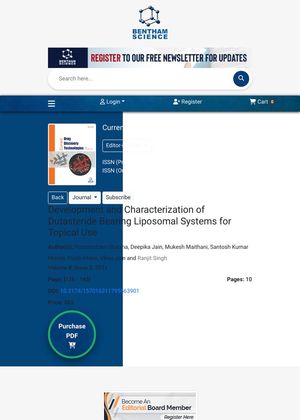Development and Characterization of Dutasteride Bearing Liposomal Systems for Topical Use
June 2011
in “Current Drug Discovery Technologies”

TLDR A new liposomal system for applying dutasteride to the skin was developed, showing better skin absorption and stability, potentially improving treatment for hair loss.
In 2011, a study was conducted to develop a dutasteride-loaded liposomal system for topical application, aiming to avoid the side effects of oral administration. The liposomes were prepared using a thin-film hydration method and optimized for entrapment efficiency, drug payload, size, and lamellarity. The most efficient system consisted of egg phosphatidylcholine (100 mg), cholesterol (50 mg), and dutasteride (5 mg), with a drug entrapment efficiency of 94.6% and a drug payload of 31.5 μg/mg of total lipids. The average vesicle size was 1.82 ± 0.15 μm. The liposomal formulations showed significantly higher skin permeation of dutasteride through excised mouse skin compared to hydro-alcoholic solution and conventional gels, with about seven times higher drug deposition in the skin. Stability studies showed the liposomal formulations were stable in refrigerated conditions for 10 weeks with negligible drug leakage or vesicle size alteration. The results suggested that this could be a better option for treating androgenetic alopecia due to improved and localized drug action in the skin.
View this study on eurekaselect.com →